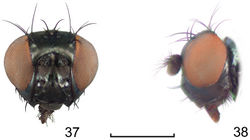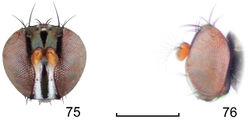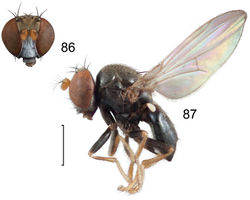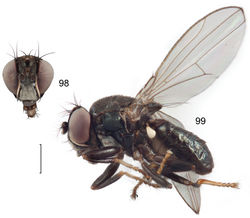| 1 | | | Gena high to very high (gena-to-eye ratio between 0.30–0.64) and with an acutely sharp genal/postgenal margin (Figs 26, 38) | | | 2 |
| |
|
| – | | | Gena relatively short (gena-to-eye ratio less than 0.20) and with genal/postgenal margin rounded | | | 4 |
| |
|
| 2 | | | Frons nearly bare, shiny (Figs 37, 38). Distal 3 tarsomeres black; male tergite 5 narrowly rounded posteriorly | | | Lamproclasiopa polita (Edwards) |
| |
|
| – | | | Frons with anterior half densely microtomentose (Fig. 24). Distal 2–3 tarsomeres yellow; male tergite 5 truncate posteriorly | | | 3 |
| |
|
| 3 | | | Female frons with broad, transverse stripe on anterior half; male mesonotum with microtomentum on anterior third | | | Lamproclasiopa lapaz sp. n. |
| |
|
| – | | | Female frons mostly bare, shiny, at most with an anteromedial spot and at base of ocellar setae and on some parts of ocellar triangle (Fig. 25); male mesonotum with broad stripe of microtomentum, stronger anteriorly, becoming weaker posterior (Fig. 24) | | | Lamproclasiopa auritunica sp. n. |
| |
|
| 4 | | | Wing maculate, at least over crossveins or generally conspicuously infuscation (Figs 58, 62, 70) | | | 5 |
| |
|
| – | | | Wing generally hyaline, lacking a maculation pattern or general infuscate | | | 8 |
| |
|
| 5 | | | |
|
| – | | | Wing with pattern of spots or with a spot over crossveins but not generally infuscate | | | 6 |
| |
|
| 6 | | | Only crossveins r-m and dm-cu with darkened cloud; vein R2+3 curved gently apically, not angulate subapically nor bearing a subapical stump vein (Fig. 62) | | | Lamproclasiopa mancha sp. n. |
| |
|
| – | | | Wing with numerous dark spots; vein R2+3 angulate subapically and bearing a stump vein with a posteroapical orientation, a second stump vein near middle (Figs 58, 70) | | | 7 |
| |
|
| 7 | | | Mesonotum with 4 brown interrupted vittae, each with elongate, mostly separate spots, none in acrostichal row (Fig. 69) | | | Lamproclasiopa painteri (Cresson) |
| |
|
| – | | | Mesonotum with 7 brown, mostly entire vittae, including a medial vitta in acrostichal area (Fig. 57) | | | Lamproclasiopa balsamae (Cresson) |
| |
|
| 8 | | | Head, thorax, and abdomen generally shiny black, only tarsi and antennal grooves yellow or cinereous (Figs 1–2, 8–9, 98–99) | | | 9 |
| |
|
| – | | | Body with extensive surfaces sparsely to densely microtomentose | | | 11 |
| |
|
| 9 | | | |
|
| – | | | Face microtomentose, silver white to golden | | | 10 |
| |
|
| 10 | | | |
|
| – | | | |
|
| 11 | | | |
|
| – | | | Forebasitarsomere yellow to slightly blackish yellow, not distinctly contrasted with coloration of apical tarsomeres | | | 12 |
| |
|
| 12 | | | Gena relatively high, height subequal to height of basal flagellomere | | | 13 |
| |
|
| – | | | Gena relatively short, height about ½ height of basal flagellomere | | | 18 |
| |
|
| 13 | | | Presutural supra-alar seta lacking; katepisternum, especially anterior half, and anteroventral portion of anepisternum shiny black; forefemur with 4–5 stout, peg-like setae on apical third along posteroventral margin | | | 14 |
| |
|
| – | | | Presutural supra-alar seta well developed; katepisternum and anepisternum thinly microtomentose, generally appearing dull, not shiny; forefemur with posteroventral setae slender, not stout and peg-like | | | 15 |
| |
|
| 14 | | | |
|
| – | | | Pocket between epandrial arms of male bottle-shaped, with basal half as a narrower neck and apical half wider (Fig. 94) | | | Lamproclasiopa aliceae sp. n. |
| |
|
| 15 | | | Eyes covered with tiny, dense setulae; facial microtomentum gray; frons concolorous with mesonotum | | | 16 |
| |
|
| – | | | Eyes covered with very sparse setulae or bare; facial microtomentum gray or dark gray; anterior portion of frons usually yellowish orange to some degree | | | 17 |
| |
|
| 16 | | | Epandrium higher than wide; aedeagus thin, narrowly funnel-like, straight (Figs 135–138) | | | Lamproclasiopa puella (Cresson) |
| |
|
| – | | | Epandrium as high as wide; aedeagus wide, with apex acutely pointed and curved (Figs 128–131) | | | Lamproclasiopa caligosa sp. n. |
| |
|
| 17 | | | Aedeagus thin, narrowly funnel-like, straight; gonites without laterodorsal extensions (Fig. 116–117) | | | Lamproclasiopa aracataca (Cresson) |
| |
|
| – | | | Aedeagus wider, curved laterally; gonites with laterodorsal extensions (Fig. 130–131) | | | Lamproclasiopa curva sp. n. |
| |
|
| 18 | | | Antenna yellow (Figs 75, 86) | | | 19 |
| |
|
| – | | | Antenna extensively darkened dorsally, only basoventral portion of basal flagellomere and pedicel partially orange to yellowish | | | 21 |
| |
|
| 19 | | | Tibiae entirely black; presutural supra-alar seta well developed; frons and face distinctly two-toned | | | Lamproclasiopa nana (Williston) |
| |
|
| – | | | Tibiae partially or entirely yellow; frons and face generally unicolorous; presutural supra-alar lacking | | | 20 |
| |
|
| 20 | | | Tibiae black brown with the distal third yellow; frons with 2 small shiny black areas lateroanteriorly | | | Lamproclasiopa furvitibia sp. n. |
| |
|
| – | | | |
|
| 21 | | | |
|
| – | | | Face mostly shiny black, especially medial portion, this area lacking a microtomentose, triangular pattern | | | 22 |
| |
|
| 22. | | | |
|
| – | | | Foretarsus yellow, apical tarsomeres yellow or becoming darker | | | 23 |
| |
|
| 23 | | | |
|
| – | | | |















![Figures 94–97. Lamproclasiopa aliceae sp. n. (USA. New Mexico: Silver City) 94 epandrium and cerci, posterior view 95 same, lateral view 96 internal structures of male terminalia (aedeagus [shaded], phallapodeme, gonite, hypandrium), ventral view 97 same, lateral view. Scale bar = 0.1 mm.](https://species-id.net/o/thumb.php?f=Zookeys-631-e10718-g033.jpg&width=210)



![Figures 114–117. Lamproclasiopa aracataca (Cresson). (Chile. Bío Bío: Santa Barbara) 114 epandrium and cerci, posterior view 115 same, lateral view 116 internal structures of male terminalia (aedeagus [shaded], phallapodeme, gonite, hypandrium), ventral view 117 same, lateral view. Scale bar = 0.1 mm.](https://species-id.net/o/thumb.php?f=Zookeys-631-e10718-g041.jpg&width=205)
![Figures 128–131. Lamproclasiopa curva sp. n. (Chile. Lanquihue: Casa Pangue) 128 epandrium and cerci, posterior view 129 same, lateral view 130 internal structures of male terminalia (aedeagus [shaded], phallapodeme, gonite, hypandrium), ventral view 131 same, lateral view. Scale bar = 0.1 mm.](https://species-id.net/o/thumb.php?f=Zookeys-631-e10718-g045.jpg&width=210)

![Figures 135–138. Lamproclasiopa puella (Cresson). (Chile. Osorno: Anticura) 135 epandrium and cerci, posterior view 136 same, lateral view 137 internal structures of male terminalia (aedeagus [shaded], phallapodeme, gonite, hypandrium), ventral view 138 same, lateral view. Scale bar = 0.1 mm.](https://species-id.net/o/thumb.php?f=Zookeys-631-e10718-g048.jpg&width=198)
